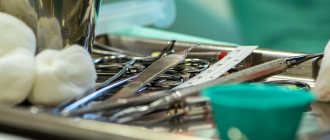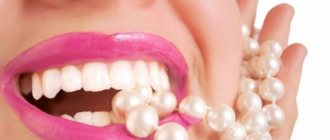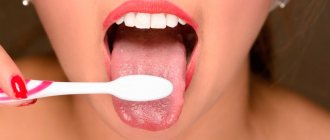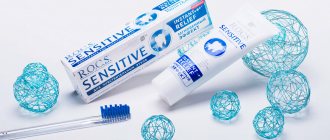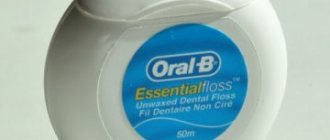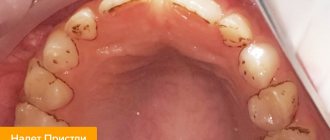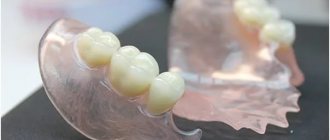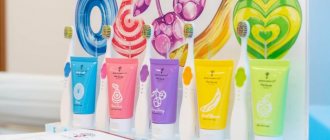From this article you will learn:
- how to properly care for your teeth,
- what is the best way to brush your teeth,
- how to protect teeth from caries.
The development of caries occurs with the participation of cariogenic bacteria in the oral cavity, which metabolize food debris stuck between the teeth after eating, turning them into lactic acid.
The acid dissolves the surface layer of tooth enamel, initially leading to the appearance of white chalky spots, which are the most initial, yet reversible, form of caries. White spots on human teeth are symptoms of the appearance of foci of demineralization of tooth enamel, in which acid has dissolved a significant part of the minerals (hydroxyapatite). If the acid attack continues for a long time, then the demineralization process reaches such a degree that the density of the enamel not only decreases, but its structural destruction occurs - a carious tooth defect is formed. The latter can be cured only by filling the tooth.
Thus, the main role in the development of caries is played by 1) microbial plaque, 2) food debris. Good regular oral hygiene can remove both of these components from teeth, but it is also important to avoid constant snacking between meals and frequent consumption of sugar-sweetened drinks. Therefore, if you are asking yourself how to get rid of tooth decay, then proper regular oral hygiene is the most important part of protecting your teeth from tooth decay and gum disease. And below we will tell you what it should be.
Important: dental care may include not only regular teeth brushing, but also additional measures that will help you strengthen your tooth enamel even more effectively. For example, the risk of developing caries can be further reduced by remineralizing teeth (we are talking about professional and home fluoridation of teeth). And we will also talk about all this in detail below.
Proper dental care -
Unfortunately, all people understand the term “good oral hygiene” differently, believing that everything is fine with their hygiene, and that all dental problems are to blame (hereinafter on the list) - water, bad heredity, pregnancy, etc. . Below we have described in detail for you how often and how to brush your teeth correctly, as well as what hygiene products are best to use.
How many times a day should you brush your teeth?
Most people know that they need to brush their teeth twice a day. Everything is correct, but this is only the minimum value. Normally, teeth are brushed after every meal, i.e. 3 times a day. If you are afraid that your colleagues at work will call you a cleaner if they see you brushing your teeth in the toilet during your lunch break, then you need to make a choice - between clean teeth, the absence of caries and bad breath, and the respect of dirty-toothed colleagues.
If a toothbrush and paste at work are unacceptable to you, then the minimum amount of hygiene that will allow you to remain Homo sapiens is dental floss + chewing gum. The most important thing in this combination is the use of dental floss, because... food gets stuck between the teeth (and we are not talking about stuck pieces of meat, but about soft food residues, which cause much more damage to the teeth, because they consist of quickly digestible carbohydrates and therefore are most quickly processed by bacteria into acid).
Diet – effective prevention of dental caries is impossible without following a diet. For example, it is very good if you brush your teeth 3 times a day after each main meal. But, if you decide to eat chocolate, cookies, sweets, nuts between main meals... the carbohydrates stick to your teeth again and bacteria immediately begin to convert them into acid. Therefore, all snacks should be eaten at the end of the main meal, and after that, immediately brush your teeth.
It is the wrong diet and frequent snacking on cookies and other carbohydrates that are the root cause of caries in children (this also applies to sugary drinks - juices, soda, liquid mixtures). Children often develop so-called bottle caries, which affects almost all teeth (when parents, to prevent the child from crying, give him a bottle of formula for the whole night or day). And without solving the problem with diet, no prevention of caries in children is simply possible.
If you are asking yourself how to get rid of caries at home, then following the recommendations of this article can almost completely save you from the appearance of new foci of caries. It's up to your willpower and motivation, because sometimes you are too lazy to get up and go straight away to brush your teeth, or finally start regularly using dental floss after every meal.
Proper hygiene scheme -
After each meal, you need to follow the following sequence: 1) flossing, 2) brushing with a toothbrush and toothpaste. If you don’t have toothpaste and a brush, you should always have dental floss and chewing gum with you. Floss will remove food debris, and chewing gum works by stimulating salivation (saliva has a certain buffering capacity that neutralizes acids in the mouth).
It is very important not only how to brush your teeth, but also when to do it. In the morning, it is best to brush your teeth after breakfast (for people with a lot of plaque and carious teeth, this can be unpleasant, so it is recommended for such patients to brush their teeth both before and after breakfast). As for all other oral hygiene sessions, teeth should be brushed within the first 5 minutes after eating.
Using dental floss –
Let's be honest - without dental floss there can be no talk of good hygiene. What do you think: why is the most common location of caries in the interdental spaces? Precisely because food debris gets stuck there, which cannot be removed by any fancy toothbrush models or even irrigators. If the instructions for a brush or an advertisement tell you that it perfectly cleans the spaces between teeth, this is all untrue and is only a publicity stunt. And this equally applies to electric, ultrasonic, and other models of brushes and attachments for them.
It is very important that you understand the following - you should use dental floss not only when you feel that a piece of meat is stuck in your teeth. After eating, so much soft sticky food debris accumulates in the interdental spaces that will not cause you any concern, but it is they (and not pieces of meat) that are the root cause of caries, because... Such food residues consist predominantly of carbohydrates that are easily digestible by bacteria.
Dental floss should be used after every meal, cleaning absolutely all dental spaces. This usually takes about 1 minute, but at the beginning (while you learn to use it) it may take longer. The thread should always be in your pocket or purse. You can use it at a party, in the restroom of a restaurant, or even just on the street. Everything will depend only on your desire to have clean teeth and a pleasant breath.
How to use dental floss correctly: video
→ Types of dental floss, and which one is better
If there are bridges on the teeth, braces -
In the presence of braces and bridges in the oral cavity, conditions are created for the retention of food debris. In the presence of bridges, food is stuffed, as a rule, under the intermediate part of the bridge, which imitates the missing tooth. Therefore, for good hygiene, an ordinary toothbrush and paste, as well as dental floss, will no longer be enough in this case (24stoma.ru).
Special devices called irrigators are designed for these purposes. Such devices deliver under pressure a thin pulsating stream of water, saturated with air microbubbles, with the help of which food debris and microbial plaque are washed away (Fig. 6). Irrigators are also indicated for patients with chronic gum inflammation, because... They also allow you to wash periodontal pockets using special nozzles.
Important: any caries you develop, even a single one, is an indicator that there are defects in your hygiene. You must understand that there is no norm for the formation of a certain number of caries lesions per year. Normally, there should be no caries at all, and if it appears, then this is a question of how correctly you brush your teeth, how regularly, whether you are familiar with dental floss, and also how correct your diet is.
When caries develops, microbial plaque and food debris remain at the edge of the corner. Adequate oral hygiene allows complete removal of both. Predisposing factors, of course, also exist. For example, a low concentration of lysozyme in saliva (this is an enzyme that inhibits the growth of plaque) is of a genetic nature, but this factor is only secondary for the development of caries.
Or the buffering capacity of saliva is too low, which does not effectively neutralize acid in the mouth. This usually occurs in patients who consume too many carbohydrates. In patients with a balanced and protein diet, the buffer capacity of saliva is always normal. Those. here again questions about your diet. Often drinking wine or fruit juices (acid), sweet soda (carbohydrates) - all this also leads to demineralization of teeth and increases the risk of caries.
Why do you need to maintain hygiene?
Maintaining hygiene is a good prevention of dental diseases. If you follow the basic rules, you can achieve the following results:
- strong teeth;
- prevention of periodontal disease and caries;
- a snow-white and attractive smile;
- freshness of breath;
- destruction of pathogenic microflora.
Smokers and people with weak immune systems need increased oral care.
If you neglect the rules of care, a person may develop respiratory diseases, heart problems, infectious diseases, problems with the gastrointestinal tract, and bad breath.
How to brush your teeth to get rid of caries -
Different oral hygiene products are not equally effective. For example, regular manual toothbrushes are significantly worse at removing microbial and pigmented plaque - compared to electric toothbrushes. This is especially important for smokers, lovers of strong tea or coffee, with irregular hygiene, as well as for patients with a high rate of plaque formation.
The head of an electric toothbrush makes about 7,600 back-and-forth movements per minute, plus at least 20,000 pulsating movements per minute. The latter allow you to loosen tightly attached dental plaque, facilitating its removal by reciprocating rotational movements and abrasive components of the toothpaste. Overall, using this brush will improve your hygiene by several levels.
→ How to choose an electric toothbrush → What are ultrasonic toothbrushes
Traditional manual toothbrushes –
If we talk about ordinary manual toothbrushes, then they should be of medium hardness (medium), because... Brushes with soft bristles will be several times worse at removing plaque. You need to change your brush not just once every 3 months, but as soon as you see that the bristles of the brush begin to stick out in different directions. Remember that all sorts of bells and whistles in the form of intersecting bristles, rubber antennae supposedly for cleaning interdental spaces and massaging gums are all just marketing.
Toothbrushes are a product with a short life cycle, so in order to attract consumer attention to their brushes, manufacturers are forced to release several new models every year that are somehow different from competitors and have more and more new characteristics. Well, the rubber antennae do not clean the interdental spaces, and they cannot massage the gums any better than ordinary nylon bristles do. And no intersecting bristles can clean the interdental spaces in their depths. But in advertising you can say all this.
In general, the main thing in a manual toothbrush is high-quality nylon bristles + proper brushing technique (+ you should not forget to floss before brushing). We hope that you know that the movements of a manual toothbrush should only be sweeping - from the gum to the tooth, while the brush should scroll slightly along its axis.
Technique for brushing teeth with a manual toothbrush: video
Thus, on the upper jaw, sweeping movements are made from top to bottom, and on the lower jaw, from bottom to top. Moreover, sweeping movements are suitable not only for cleaning not only the front, but also the lingual/palatal surfaces of the teeth. And only the chewing surfaces of the teeth are cleaned with the usual reciprocating horizontal movements of the toothbrush.
Which toothpastes are best for caries?
Fluoride-containing toothpastes can help you get rid of dental caries. They have the best caries-preventive effect. Fluoride ions interact with hydroxyapatite, which makes up tooth enamel, turning it into fluorohydroxyapatite. The latter is much more resistant to the effects of cariogenic bacteria and the acid they produce than ordinary hydroxyapatite.
In turn, pastes with calcium, although they help saturate tooth enamel with calcium, they do not have such a pronounced anti-caries effect as pastes with fluoride. To enhance the caries-preventive effect of pastes with calcium, xylitol is additionally added to them. However, studies show that when using toothpastes without fluoride, the incidence of caries is at least 30% higher (therefore, their use is justified only in regions with high concentrations of fluoride in drinking water).
→ Fluoride content in drinking water by regions of Russia
Examples of the best toothpastes -
In our opinion, one of the best options for children and adults are Colgate® ELMEX toothpastes. These pastes contain the most effective form of fluoride - aminofluoride (synonym - olaflur). Elmex toothpastes are a professional line of Colgate toothpastes, which use more expensive and high-quality components compared to regular toothpastes from this company. You can also give high marks to toothpastes of the President brand (Italy).
However, even the best toothpastes such as Elmex or President (as well as any other high-quality therapeutic and prophylactic toothpastes from other manufacturers) are an excellent remedy for caries, mainly only in patients with regular oral hygiene. All these pastes for teenagers and adults contain a fairly high concentration of fluoride 1450 ppm, which is quite enough for excellent caries prevention with regular hygiene.
However, even this concentration is not enough to prevent caries in patients with irregular hygiene. For such patients, there is a separate group of toothpastes with an increased dosage of fluoride. For children over 16 years of age and adults, Colgate® Duraphat medicinal paste containing 5000 ppm fluoride can be used for intensive caries prevention, and for children over 10 years old the same paste with 2800 ppm fluoride can be used (see links below).
- The best medicinal pastes for caries
- The best toothpastes for children - rating 2021
Do I need an irrigator?
Irrigator
For basic dental care, a brush, tongue scraper, and dental floss are sufficient. However, once you purchase this electrical appliance, you will never be able to part with it.
The essence of its work is that water or a special solution is supplied under high pressure to the thin nozzles of the device, thanks to which it very effectively cleans the interdental space, massages the gums, removes plaque from the gum pockets and cleans the tongue.
Professional dental treatment with fluoride –
At the beginning of the article, we already told you that the initial stage of caries develops due to exposure to acid secreted by cariogenic bacteria. This acid dissolves the surface layer of enamel - as a result of which the enamel loses calcium, i.e. demineralization of the enamel occurs. However, there are therapeutic measures that can strengthen tooth enamel by saturating it with minerals (fluorine and calcium). This process is called tooth remineralization.
Remineralization is not only professional (carried out in a dental office), but it can also be easily done independently using the right quality products. At home, you constantly use toothpastes with fluoride or calcium, which also contribute to the remineralization of tooth enamel, despite moderate concentrations of active ingredients. To strengthen enamel in children and adults, dentists most often use the method of professional fluoridation of teeth (using highly concentrated varnishes and gels).
Professional fluoridation of teeth is more effective compared to fluoride-containing therapeutic and prophylactic toothpastes. For example, the fluoride concentration in dental varnish is usually 22,600 ppm, and conventional dental toothpastes contain a maximum of 1,450 ppm of fluoride. And in Colgate® Duraphat medicinal pastes (which we described above) – 2800 or 5000 ppm.
In what cases is it better to choose fluoride treatment of teeth at the dentist, and in what cases is it better to use medicated toothpastes with a high dosage of fluoride at home? Read the article on fluoridation of teeth (see link above). But in general, the recommendations of the World Health Organization (WHO) recommend that fluoride prevention of caries should include both directions: firstly, the constant use of low doses of fluorides at home, and secondly, periodic professional applications of high doses of fluorides at the dentist (1 time in 3- 6 months).
The mechanism of action of fluorides (explanations below the picture) –
- Demineralization - when the pH of the oral fluid drops to pH 5.5 (i.e. becomes acidic) - the surface layer of enamel begins to dissolve and lose calcium and other trace elements. This is the starting point for the development of caries. A pH below 5.5 means an acidic environment, which is formed in the oral cavity under the influence of cariogenic microorganisms that “digest” food debris into organic acids.
- Remineralization - the surface of the tooth is coated with fluoride varnish, which promotes the formation of a layer of calcium fluoride (CaF2) on the surface of the tooth, from which calcium and fluoride ions penetrate into the enamel surface. There, fluoride ions bind to hydroxyapatite (the substance from which enamel is made), turning it into fluorohydroxyapatite. The latter is much more resistant to acid, and its dissolution begins only at pH 4.5 (i.e. at a higher acid concentration in the oral cavity). This ensures the anti-caries effect of fluorides.
What is plaque and why is it dangerous?
If you carefully scrape your teeth with a fingernail in the morning or even during the day, you can find a white translucent coating. This is the plaque that causes diseases. If you do not remove such plaque with a toothbrush, it can harden within 48 hours. Such plaque cannot always be removed with a toothbrush. The hardness of the stone appears after 10-12 days. This coating already looks yellow or brown.
Preventing dental caries: conclusions
In this article we tried to give answers to the questions: how to get rid of caries, how to prevent caries, how to defeat caries, is there any salvation from caries... Let us repeat that there is the following algorithm for effective prevention of caries:
- Firstly , measures aimed at removing soft plaque and tartar. This is nothing more than oral hygiene. It should be noted that good hygiene is the best cure for caries.
- Secondly , a rational diet that limits the use of easily digestible carbohydrates (found in sweets, flour, and sugary drinks) between main meals and teaching your children to do this is also an excellent remedy for caries.
- Thirdly , these are measures aimed at increasing the resistance of tooth enamel to the destructive effects of organic acids produced by cariogenic microorganisms in the oral cavity.
This includes the use of toothpastes with calcium and fluoride at home, as well as periodic visits to the dentist once every 3-6 months (the frequency depends on the growth rate of new caries lesions). Also, preventive actions include sealing the fissures of teeth in children, in which deep fissures (grooves) on the chewing surfaces of the teeth are sealed with liquid filling materials. We hope that our article on the topic: How to prevent dental caries, effective caries prevention - turned out to be useful to you!
Sources:
1. Higher professional education of the author in dentistry, 2. Based on personal experience as a periodontist, 3. The European Academy of Paediatric Dentistry (USA), 4. National Library of Medicine (USA), 5. “Therapeutic dentistry. Textbook" (Borovsky E.), 6. "Pediatric therapeutic dentistry. National leadership" (Leontyev V.).
How to choose toothpaste?
Not all people attach importance to the right choice of toothpaste. Meanwhile, the quality of cleaning and the results of dental care largely depend on it. Dentists recommend choosing products containing calcium, fluoride, and natural herbal ingredients. If necessary, medicinal pastes (for example, with chlorhexidine) can be used, but the period of their use should not exceed 2-3 weeks.
If your teeth are sensitive, you should be careful when using products with a whitening effect. If such pastes are abused, there is a high probability of the formation of wedge-shaped defects - small gaps that appear on the outer surface of the front teeth. Over time, they can lead to exposure of the neck of the tooth and destruction of the dental crown.
Comments
[…] basically a diet rich in vitamins, careful oral care, giving up bad habits, as well as control over […]
Salivary stone disease - symptoms and methods of treating the disease (09/19/2018 at 09:02) Reply to comment
My mother taught me to take care of oral hygiene from childhood. I recently bought Sanorin Loris spray for dry mouth, and it also kills germs well. I use it regularly now.
Alsou (07/06/2019 at 17:50) Reply to comment
